Human Resource Management & Development
VerifiedAdded on 2020/07/22
|16
|5292
|54
AI Summary
This assignment involves an in-depth analysis of human resource management (HRM) strategies and their impact on organizational performance. Students are required to explore various theories and models, including Kolb's Learning Styles and Unger's study on entrepreneurial success. The assignment also covers topics such as strategic HRM, organization development and change, global talent management, and human health risk assessment.
Contribute Materials
Your contribution can guide someone’s learning journey. Share your
documents today.
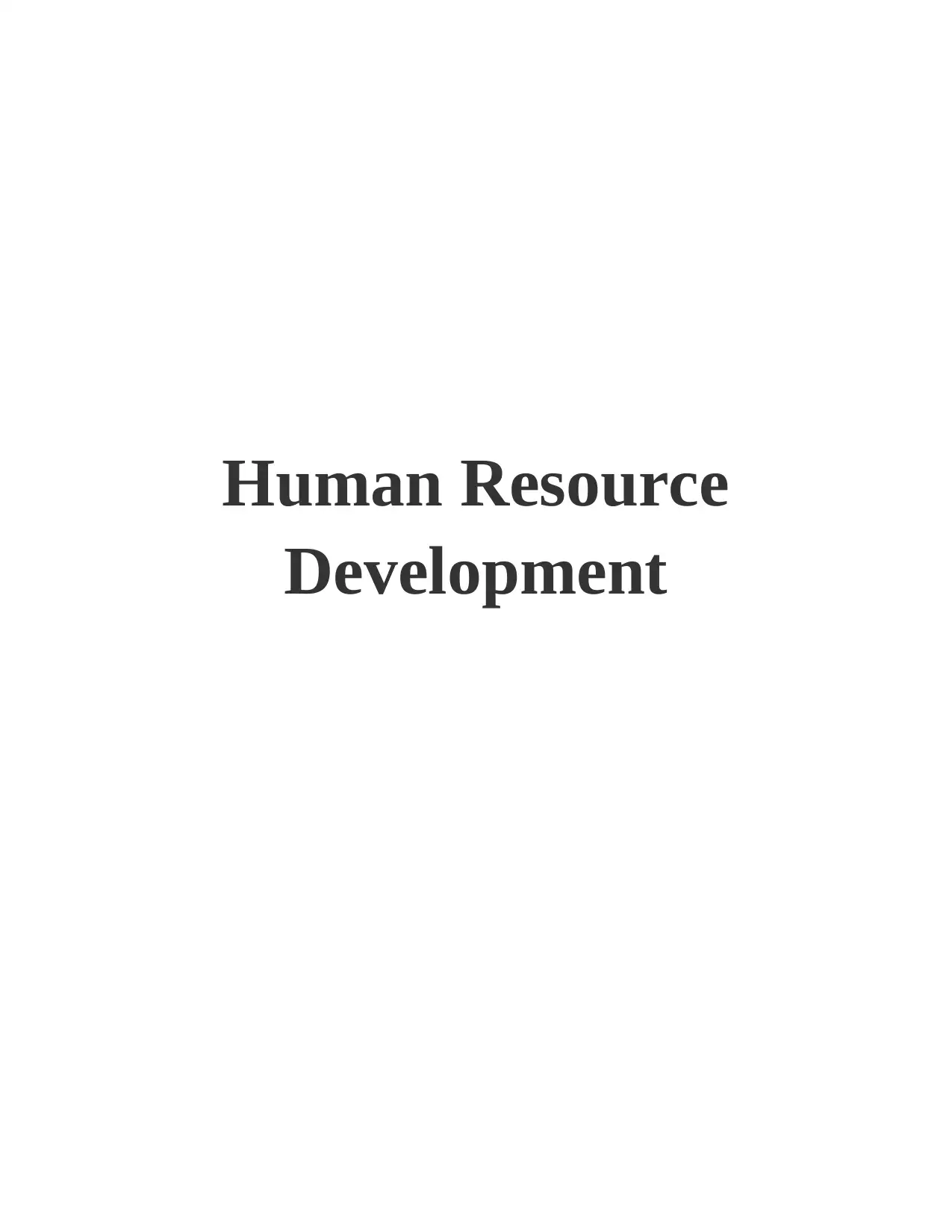
Human Resource
Development
Development
Secure Best Marks with AI Grader
Need help grading? Try our AI Grader for instant feedback on your assignments.
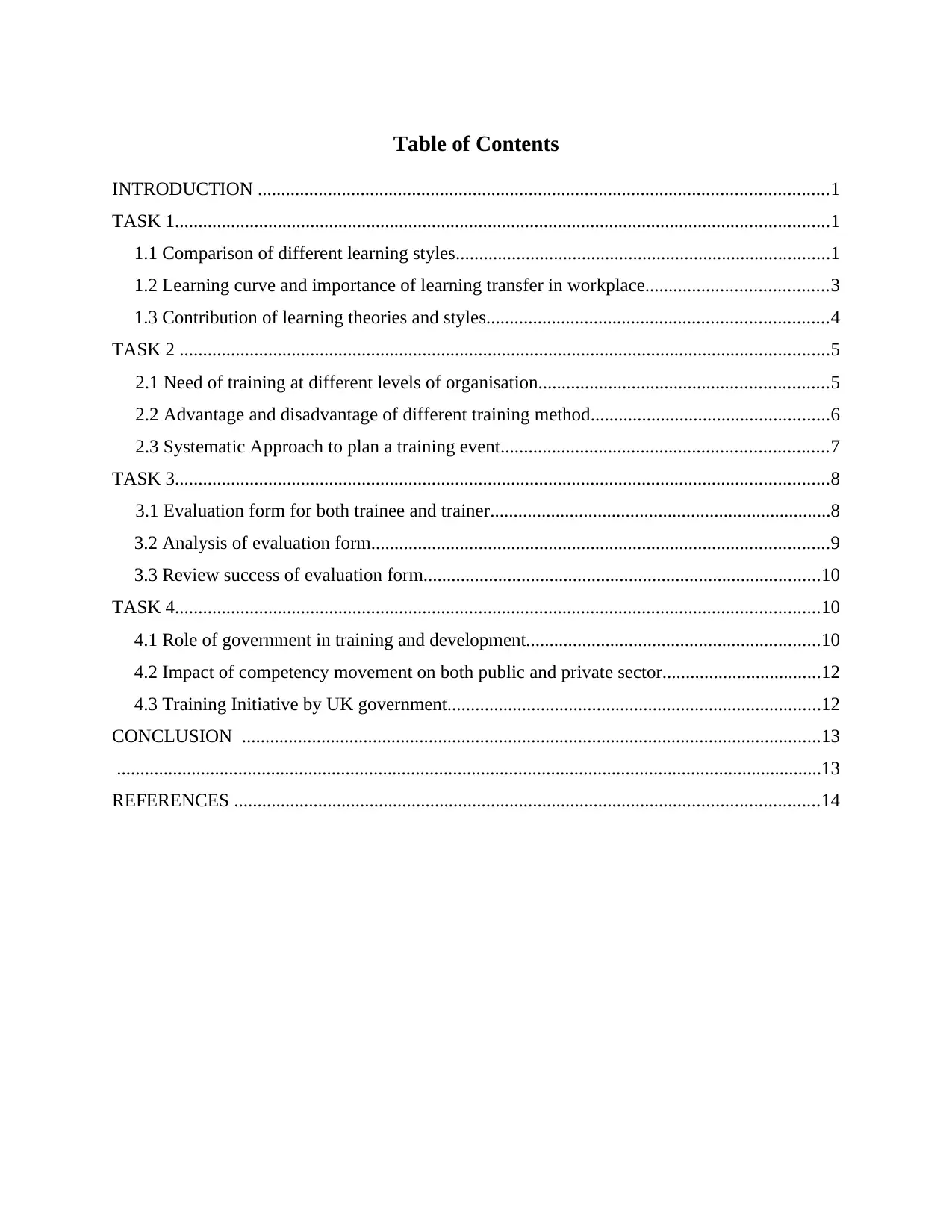
Table of Contents
INTRODUCTION ..........................................................................................................................1
TASK 1............................................................................................................................................1
1.1 Comparison of different learning styles................................................................................1
1.2 Learning curve and importance of learning transfer in workplace.......................................3
1.3 Contribution of learning theories and styles.........................................................................4
TASK 2 ...........................................................................................................................................5
2.1 Need of training at different levels of organisation..............................................................5
2.2 Advantage and disadvantage of different training method...................................................6
2.3 Systematic Approach to plan a training event......................................................................7
TASK 3............................................................................................................................................8
3.1 Evaluation form for both trainee and trainer.........................................................................8
3.2 Analysis of evaluation form..................................................................................................9
3.3 Review success of evaluation form.....................................................................................10
TASK 4..........................................................................................................................................10
4.1 Role of government in training and development...............................................................10
4.2 Impact of competency movement on both public and private sector..................................12
4.3 Training Initiative by UK government................................................................................12
CONCLUSION ............................................................................................................................13
.......................................................................................................................................................13
REFERENCES .............................................................................................................................14
INTRODUCTION ..........................................................................................................................1
TASK 1............................................................................................................................................1
1.1 Comparison of different learning styles................................................................................1
1.2 Learning curve and importance of learning transfer in workplace.......................................3
1.3 Contribution of learning theories and styles.........................................................................4
TASK 2 ...........................................................................................................................................5
2.1 Need of training at different levels of organisation..............................................................5
2.2 Advantage and disadvantage of different training method...................................................6
2.3 Systematic Approach to plan a training event......................................................................7
TASK 3............................................................................................................................................8
3.1 Evaluation form for both trainee and trainer.........................................................................8
3.2 Analysis of evaluation form..................................................................................................9
3.3 Review success of evaluation form.....................................................................................10
TASK 4..........................................................................................................................................10
4.1 Role of government in training and development...............................................................10
4.2 Impact of competency movement on both public and private sector..................................12
4.3 Training Initiative by UK government................................................................................12
CONCLUSION ............................................................................................................................13
.......................................................................................................................................................13
REFERENCES .............................................................................................................................14
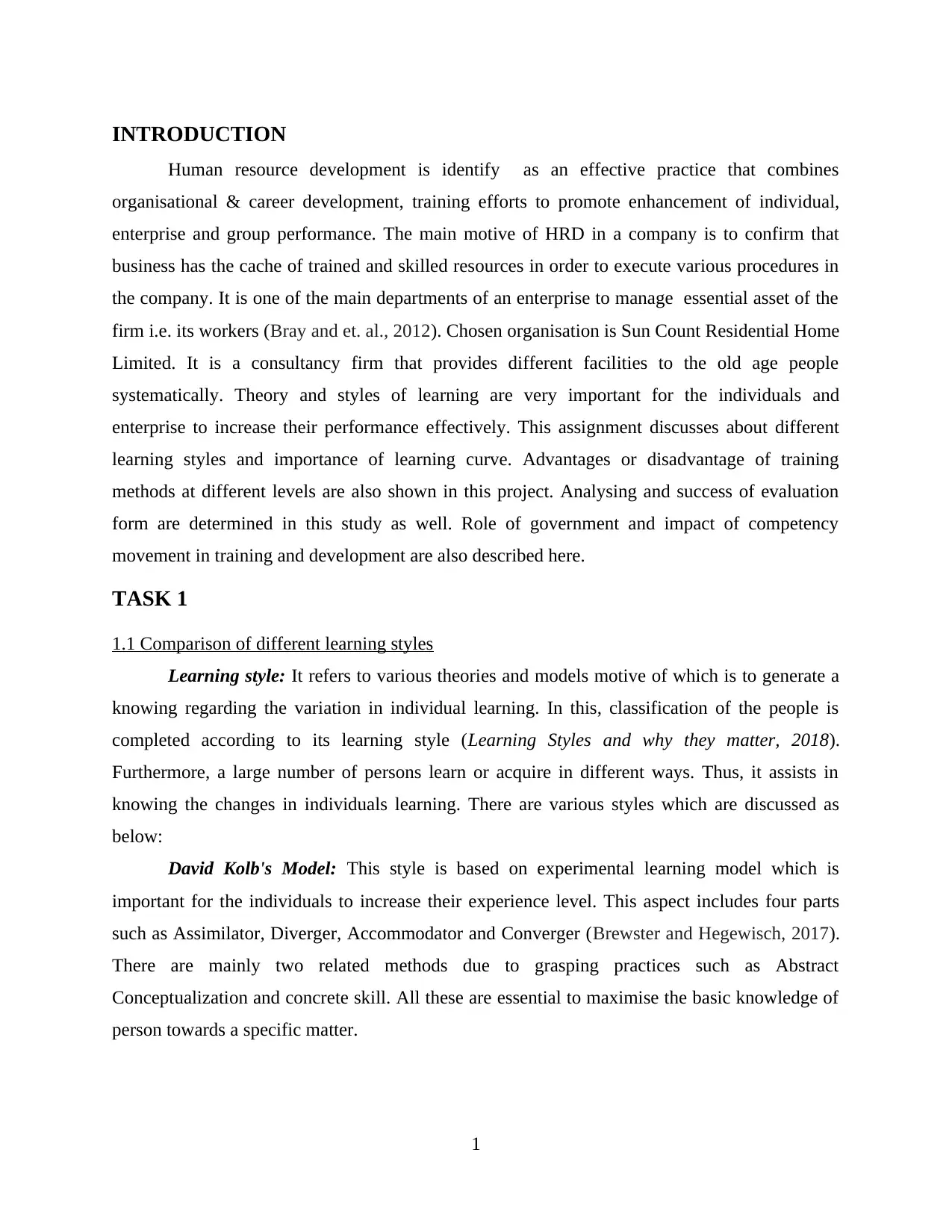
INTRODUCTION
Human resource development is identify as an effective practice that combines
organisational & career development, training efforts to promote enhancement of individual,
enterprise and group performance. The main motive of HRD in a company is to confirm that
business has the cache of trained and skilled resources in order to execute various procedures in
the company. It is one of the main departments of an enterprise to manage essential asset of the
firm i.e. its workers (Bray and et. al., 2012). Chosen organisation is Sun Count Residential Home
Limited. It is a consultancy firm that provides different facilities to the old age people
systematically. Theory and styles of learning are very important for the individuals and
enterprise to increase their performance effectively. This assignment discusses about different
learning styles and importance of learning curve. Advantages or disadvantage of training
methods at different levels are also shown in this project. Analysing and success of evaluation
form are determined in this study as well. Role of government and impact of competency
movement in training and development are also described here.
TASK 1
1.1 Comparison of different learning styles
Learning style: It refers to various theories and models motive of which is to generate a
knowing regarding the variation in individual learning. In this, classification of the people is
completed according to its learning style (Learning Styles and why they matter, 2018).
Furthermore, a large number of persons learn or acquire in different ways. Thus, it assists in
knowing the changes in individuals learning. There are various styles which are discussed as
below:
David Kolb's Model: This style is based on experimental learning model which is
important for the individuals to increase their experience level. This aspect includes four parts
such as Assimilator, Diverger, Accommodator and Converger (Brewster and Hegewisch, 2017).
There are mainly two related methods due to grasping practices such as Abstract
Conceptualization and concrete skill. All these are essential to maximise the basic knowledge of
person towards a specific matter.
1
Human resource development is identify as an effective practice that combines
organisational & career development, training efforts to promote enhancement of individual,
enterprise and group performance. The main motive of HRD in a company is to confirm that
business has the cache of trained and skilled resources in order to execute various procedures in
the company. It is one of the main departments of an enterprise to manage essential asset of the
firm i.e. its workers (Bray and et. al., 2012). Chosen organisation is Sun Count Residential Home
Limited. It is a consultancy firm that provides different facilities to the old age people
systematically. Theory and styles of learning are very important for the individuals and
enterprise to increase their performance effectively. This assignment discusses about different
learning styles and importance of learning curve. Advantages or disadvantage of training
methods at different levels are also shown in this project. Analysing and success of evaluation
form are determined in this study as well. Role of government and impact of competency
movement in training and development are also described here.
TASK 1
1.1 Comparison of different learning styles
Learning style: It refers to various theories and models motive of which is to generate a
knowing regarding the variation in individual learning. In this, classification of the people is
completed according to its learning style (Learning Styles and why they matter, 2018).
Furthermore, a large number of persons learn or acquire in different ways. Thus, it assists in
knowing the changes in individuals learning. There are various styles which are discussed as
below:
David Kolb's Model: This style is based on experimental learning model which is
important for the individuals to increase their experience level. This aspect includes four parts
such as Assimilator, Diverger, Accommodator and Converger (Brewster and Hegewisch, 2017).
There are mainly two related methods due to grasping practices such as Abstract
Conceptualization and concrete skill. All these are essential to maximise the basic knowledge of
person towards a specific matter.
1
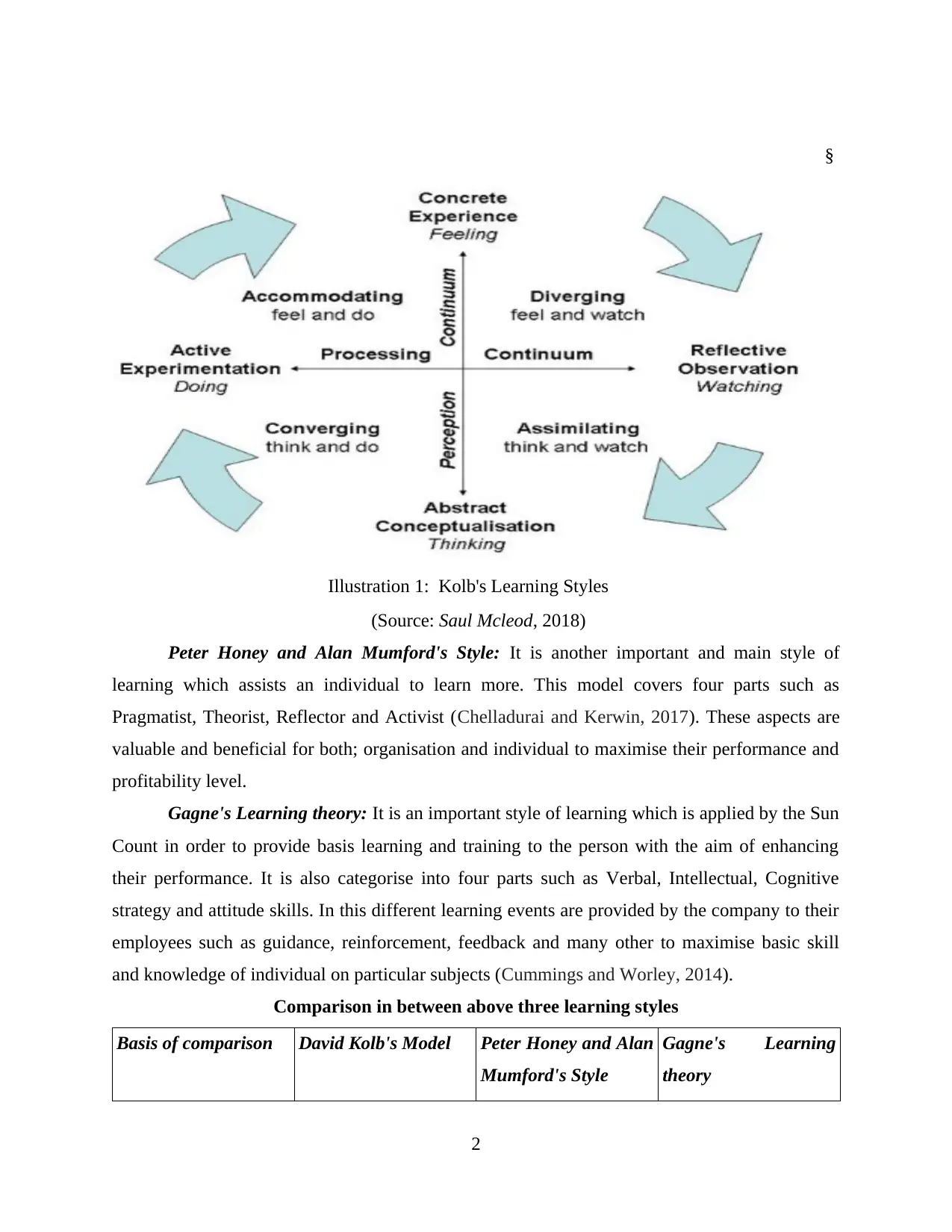
Illustration 1: Kolb's Learning Styles
§
(Source: Saul Mcleod, 2018)
Peter Honey and Alan Mumford's Style: It is another important and main style of
learning which assists an individual to learn more. This model covers four parts such as
Pragmatist, Theorist, Reflector and Activist (Chelladurai and Kerwin, 2017). These aspects are
valuable and beneficial for both; organisation and individual to maximise their performance and
profitability level.
Gagne's Learning theory: It is an important style of learning which is applied by the Sun
Count in order to provide basis learning and training to the person with the aim of enhancing
their performance. It is also categorise into four parts such as Verbal, Intellectual, Cognitive
strategy and attitude skills. In this different learning events are provided by the company to their
employees such as guidance, reinforcement, feedback and many other to maximise basic skill
and knowledge of individual on particular subjects (Cummings and Worley, 2014).
Comparison in between above three learning styles
Basis of comparison David Kolb's Model Peter Honey and Alan
Mumford's Style
Gagne's Learning
theory
2
§
(Source: Saul Mcleod, 2018)
Peter Honey and Alan Mumford's Style: It is another important and main style of
learning which assists an individual to learn more. This model covers four parts such as
Pragmatist, Theorist, Reflector and Activist (Chelladurai and Kerwin, 2017). These aspects are
valuable and beneficial for both; organisation and individual to maximise their performance and
profitability level.
Gagne's Learning theory: It is an important style of learning which is applied by the Sun
Count in order to provide basis learning and training to the person with the aim of enhancing
their performance. It is also categorise into four parts such as Verbal, Intellectual, Cognitive
strategy and attitude skills. In this different learning events are provided by the company to their
employees such as guidance, reinforcement, feedback and many other to maximise basic skill
and knowledge of individual on particular subjects (Cummings and Worley, 2014).
Comparison in between above three learning styles
Basis of comparison David Kolb's Model Peter Honey and Alan
Mumford's Style
Gagne's Learning
theory
2
Secure Best Marks with AI Grader
Need help grading? Try our AI Grader for instant feedback on your assignments.
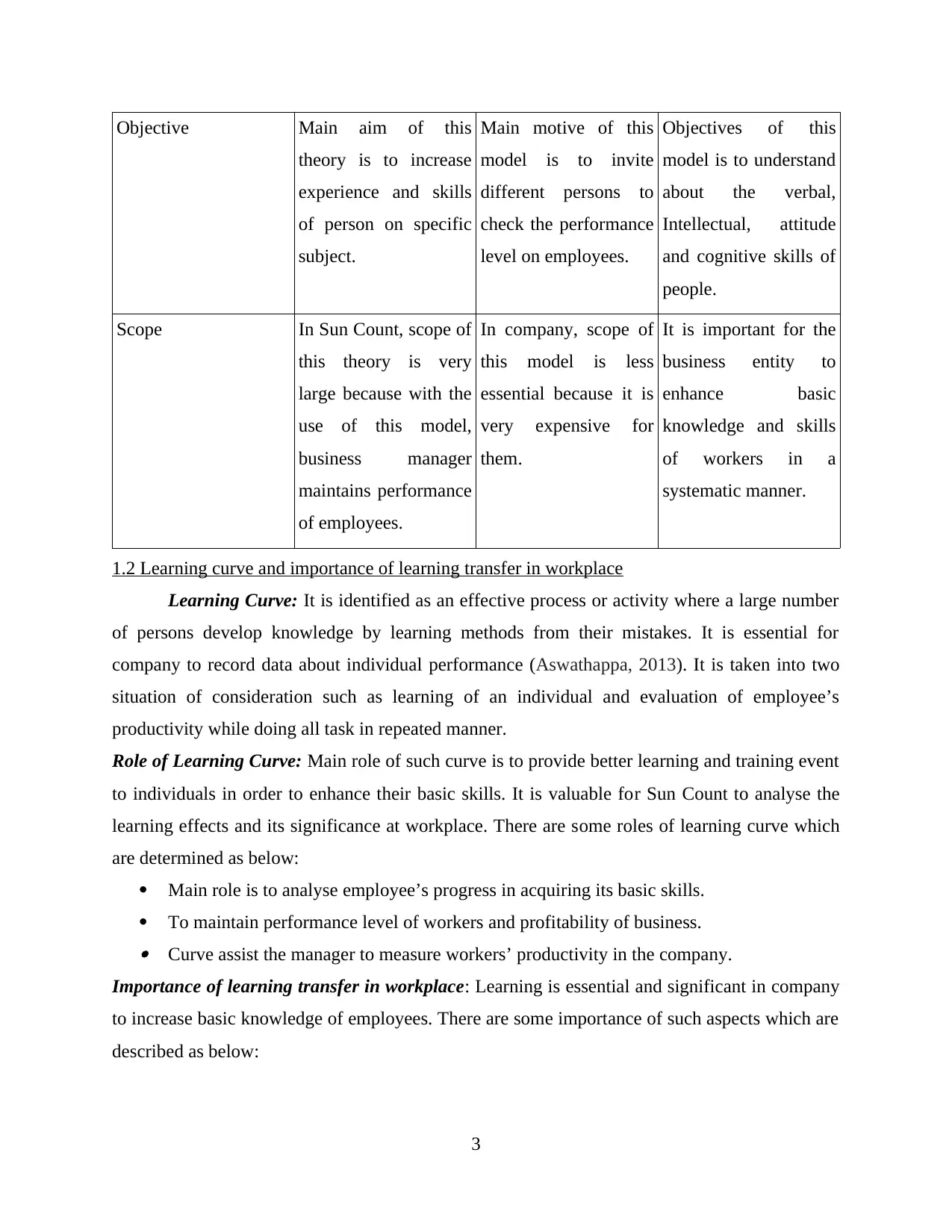
Objective Main aim of this
theory is to increase
experience and skills
of person on specific
subject.
Main motive of this
model is to invite
different persons to
check the performance
level on employees.
Objectives of this
model is to understand
about the verbal,
Intellectual, attitude
and cognitive skills of
people.
Scope In Sun Count, scope of
this theory is very
large because with the
use of this model,
business manager
maintains performance
of employees.
In company, scope of
this model is less
essential because it is
very expensive for
them.
It is important for the
business entity to
enhance basic
knowledge and skills
of workers in a
systematic manner.
1.2 Learning curve and importance of learning transfer in workplace
Learning Curve: It is identified as an effective process or activity where a large number
of persons develop knowledge by learning methods from their mistakes. It is essential for
company to record data about individual performance (Aswathappa, 2013). It is taken into two
situation of consideration such as learning of an individual and evaluation of employee’s
productivity while doing all task in repeated manner.
Role of Learning Curve: Main role of such curve is to provide better learning and training event
to individuals in order to enhance their basic skills. It is valuable for Sun Count to analyse the
learning effects and its significance at workplace. There are some roles of learning curve which
are determined as below:
Main role is to analyse employee’s progress in acquiring its basic skills.
To maintain performance level of workers and profitability of business. Curve assist the manager to measure workers’ productivity in the company.
Importance of learning transfer in workplace: Learning is essential and significant in company
to increase basic knowledge of employees. There are some importance of such aspects which are
described as below:
3
theory is to increase
experience and skills
of person on specific
subject.
Main motive of this
model is to invite
different persons to
check the performance
level on employees.
Objectives of this
model is to understand
about the verbal,
Intellectual, attitude
and cognitive skills of
people.
Scope In Sun Count, scope of
this theory is very
large because with the
use of this model,
business manager
maintains performance
of employees.
In company, scope of
this model is less
essential because it is
very expensive for
them.
It is important for the
business entity to
enhance basic
knowledge and skills
of workers in a
systematic manner.
1.2 Learning curve and importance of learning transfer in workplace
Learning Curve: It is identified as an effective process or activity where a large number
of persons develop knowledge by learning methods from their mistakes. It is essential for
company to record data about individual performance (Aswathappa, 2013). It is taken into two
situation of consideration such as learning of an individual and evaluation of employee’s
productivity while doing all task in repeated manner.
Role of Learning Curve: Main role of such curve is to provide better learning and training event
to individuals in order to enhance their basic skills. It is valuable for Sun Count to analyse the
learning effects and its significance at workplace. There are some roles of learning curve which
are determined as below:
Main role is to analyse employee’s progress in acquiring its basic skills.
To maintain performance level of workers and profitability of business. Curve assist the manager to measure workers’ productivity in the company.
Importance of learning transfer in workplace: Learning is essential and significant in company
to increase basic knowledge of employees. There are some importance of such aspects which are
described as below:
3
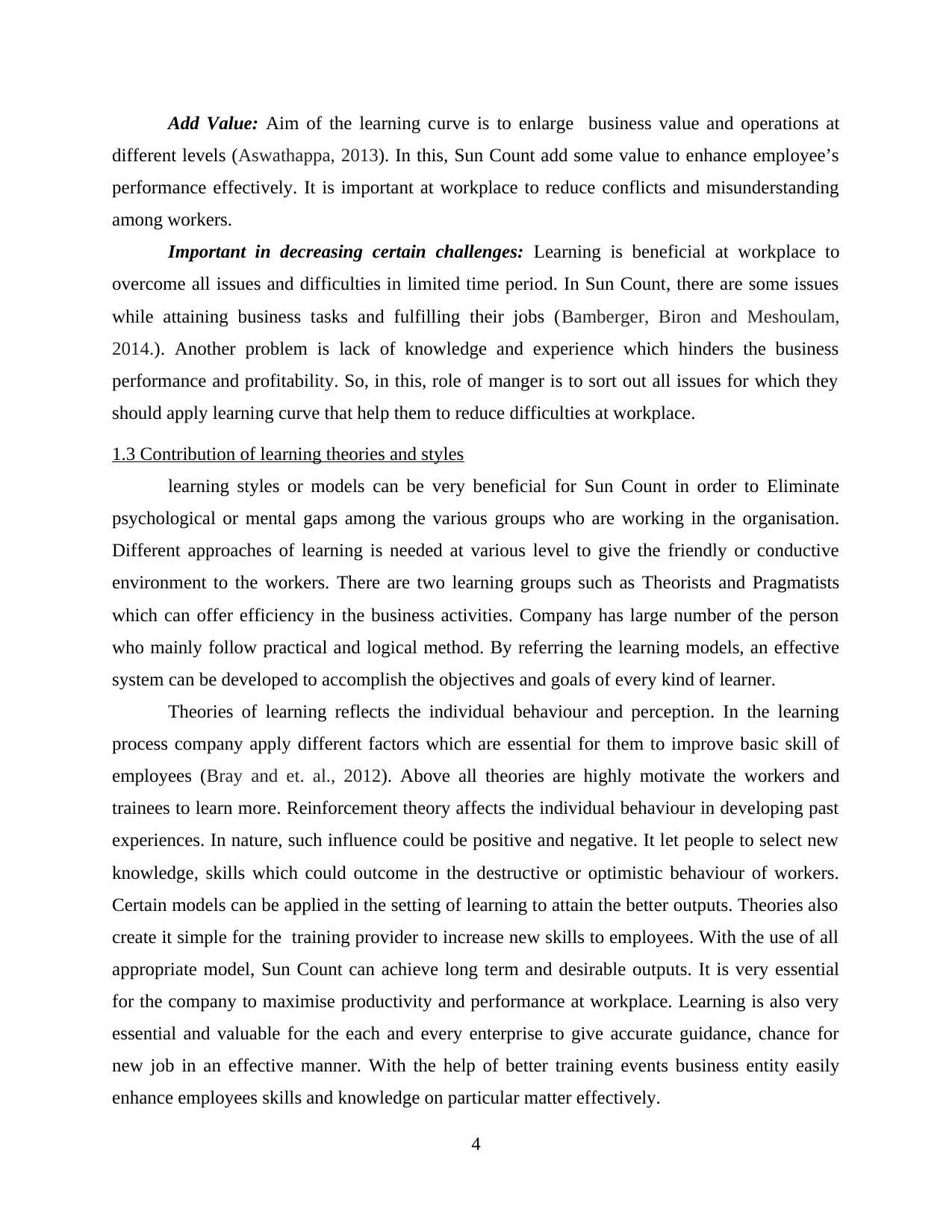
Add Value: Aim of the learning curve is to enlarge business value and operations at
different levels (Aswathappa, 2013). In this, Sun Count add some value to enhance employee’s
performance effectively. It is important at workplace to reduce conflicts and misunderstanding
among workers.
Important in decreasing certain challenges: Learning is beneficial at workplace to
overcome all issues and difficulties in limited time period. In Sun Count, there are some issues
while attaining business tasks and fulfilling their jobs (Bamberger, Biron and Meshoulam,
2014.). Another problem is lack of knowledge and experience which hinders the business
performance and profitability. So, in this, role of manger is to sort out all issues for which they
should apply learning curve that help them to reduce difficulties at workplace.
1.3 Contribution of learning theories and styles
learning styles or models can be very beneficial for Sun Count in order to Eliminate
psychological or mental gaps among the various groups who are working in the organisation.
Different approaches of learning is needed at various level to give the friendly or conductive
environment to the workers. There are two learning groups such as Theorists and Pragmatists
which can offer efficiency in the business activities. Company has large number of the person
who mainly follow practical and logical method. By referring the learning models, an effective
system can be developed to accomplish the objectives and goals of every kind of learner.
Theories of learning reflects the individual behaviour and perception. In the learning
process company apply different factors which are essential for them to improve basic skill of
employees (Bray and et. al., 2012). Above all theories are highly motivate the workers and
trainees to learn more. Reinforcement theory affects the individual behaviour in developing past
experiences. In nature, such influence could be positive and negative. It let people to select new
knowledge, skills which could outcome in the destructive or optimistic behaviour of workers.
Certain models can be applied in the setting of learning to attain the better outputs. Theories also
create it simple for the training provider to increase new skills to employees. With the use of all
appropriate model, Sun Count can achieve long term and desirable outputs. It is very essential
for the company to maximise productivity and performance at workplace. Learning is also very
essential and valuable for the each and every enterprise to give accurate guidance, chance for
new job in an effective manner. With the help of better training events business entity easily
enhance employees skills and knowledge on particular matter effectively.
4
different levels (Aswathappa, 2013). In this, Sun Count add some value to enhance employee’s
performance effectively. It is important at workplace to reduce conflicts and misunderstanding
among workers.
Important in decreasing certain challenges: Learning is beneficial at workplace to
overcome all issues and difficulties in limited time period. In Sun Count, there are some issues
while attaining business tasks and fulfilling their jobs (Bamberger, Biron and Meshoulam,
2014.). Another problem is lack of knowledge and experience which hinders the business
performance and profitability. So, in this, role of manger is to sort out all issues for which they
should apply learning curve that help them to reduce difficulties at workplace.
1.3 Contribution of learning theories and styles
learning styles or models can be very beneficial for Sun Count in order to Eliminate
psychological or mental gaps among the various groups who are working in the organisation.
Different approaches of learning is needed at various level to give the friendly or conductive
environment to the workers. There are two learning groups such as Theorists and Pragmatists
which can offer efficiency in the business activities. Company has large number of the person
who mainly follow practical and logical method. By referring the learning models, an effective
system can be developed to accomplish the objectives and goals of every kind of learner.
Theories of learning reflects the individual behaviour and perception. In the learning
process company apply different factors which are essential for them to improve basic skill of
employees (Bray and et. al., 2012). Above all theories are highly motivate the workers and
trainees to learn more. Reinforcement theory affects the individual behaviour in developing past
experiences. In nature, such influence could be positive and negative. It let people to select new
knowledge, skills which could outcome in the destructive or optimistic behaviour of workers.
Certain models can be applied in the setting of learning to attain the better outputs. Theories also
create it simple for the training provider to increase new skills to employees. With the use of all
appropriate model, Sun Count can achieve long term and desirable outputs. It is very essential
for the company to maximise productivity and performance at workplace. Learning is also very
essential and valuable for the each and every enterprise to give accurate guidance, chance for
new job in an effective manner. With the help of better training events business entity easily
enhance employees skills and knowledge on particular matter effectively.
4
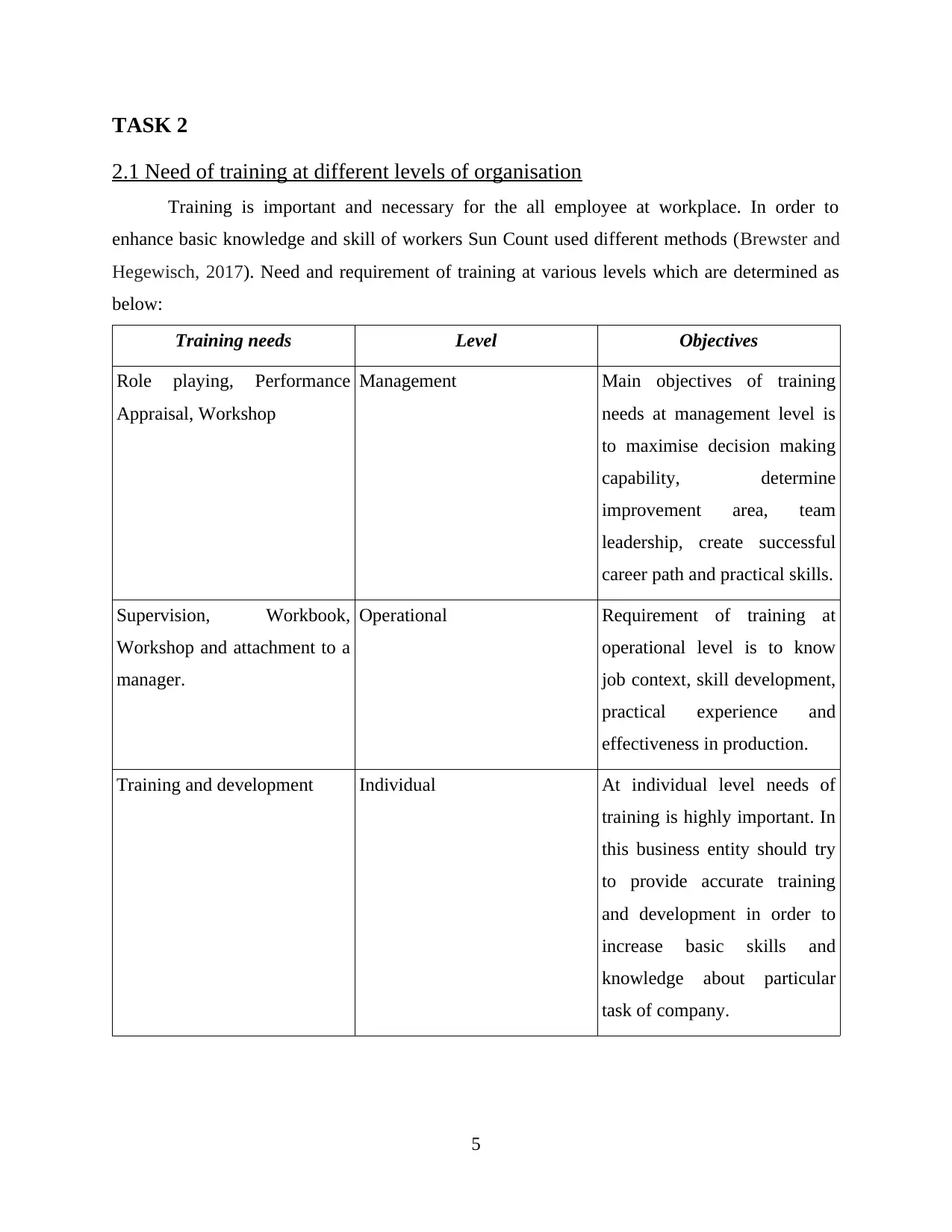
TASK 2
2.1 Need of training at different levels of organisation
Training is important and necessary for the all employee at workplace. In order to
enhance basic knowledge and skill of workers Sun Count used different methods (Brewster and
Hegewisch, 2017). Need and requirement of training at various levels which are determined as
below:
Training needs Level Objectives
Role playing, Performance
Appraisal, Workshop
Management Main objectives of training
needs at management level is
to maximise decision making
capability, determine
improvement area, team
leadership, create successful
career path and practical skills.
Supervision, Workbook,
Workshop and attachment to a
manager.
Operational Requirement of training at
operational level is to know
job context, skill development,
practical experience and
effectiveness in production.
Training and development Individual At individual level needs of
training is highly important. In
this business entity should try
to provide accurate training
and development in order to
increase basic skills and
knowledge about particular
task of company.
5
2.1 Need of training at different levels of organisation
Training is important and necessary for the all employee at workplace. In order to
enhance basic knowledge and skill of workers Sun Count used different methods (Brewster and
Hegewisch, 2017). Need and requirement of training at various levels which are determined as
below:
Training needs Level Objectives
Role playing, Performance
Appraisal, Workshop
Management Main objectives of training
needs at management level is
to maximise decision making
capability, determine
improvement area, team
leadership, create successful
career path and practical skills.
Supervision, Workbook,
Workshop and attachment to a
manager.
Operational Requirement of training at
operational level is to know
job context, skill development,
practical experience and
effectiveness in production.
Training and development Individual At individual level needs of
training is highly important. In
this business entity should try
to provide accurate training
and development in order to
increase basic skills and
knowledge about particular
task of company.
5
Paraphrase This Document
Need a fresh take? Get an instant paraphrase of this document with our AI Paraphraser
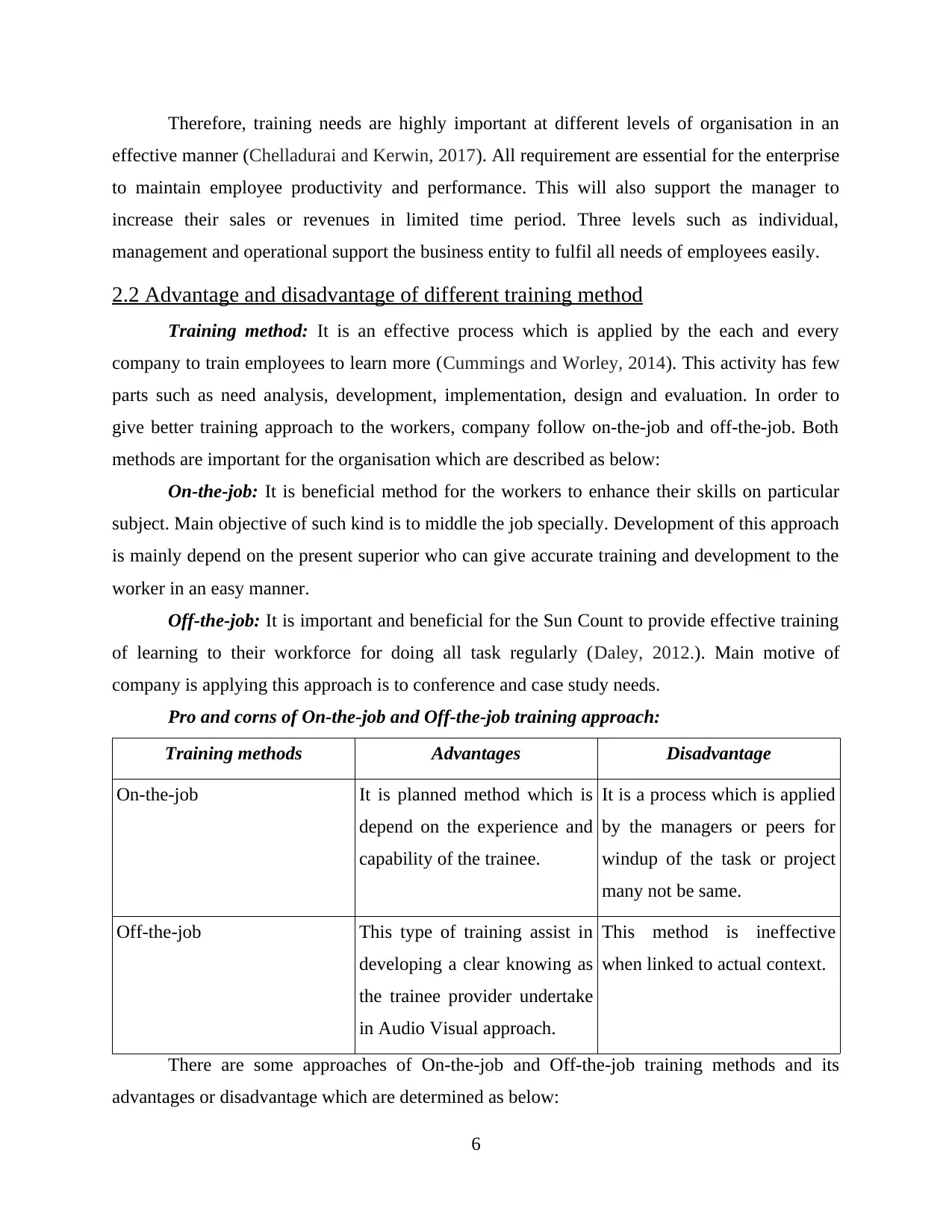
Therefore, training needs are highly important at different levels of organisation in an
effective manner (Chelladurai and Kerwin, 2017). All requirement are essential for the enterprise
to maintain employee productivity and performance. This will also support the manager to
increase their sales or revenues in limited time period. Three levels such as individual,
management and operational support the business entity to fulfil all needs of employees easily.
2.2 Advantage and disadvantage of different training method
Training method: It is an effective process which is applied by the each and every
company to train employees to learn more (Cummings and Worley, 2014). This activity has few
parts such as need analysis, development, implementation, design and evaluation. In order to
give better training approach to the workers, company follow on-the-job and off-the-job. Both
methods are important for the organisation which are described as below:
On-the-job: It is beneficial method for the workers to enhance their skills on particular
subject. Main objective of such kind is to middle the job specially. Development of this approach
is mainly depend on the present superior who can give accurate training and development to the
worker in an easy manner.
Off-the-job: It is important and beneficial for the Sun Count to provide effective training
of learning to their workforce for doing all task regularly (Daley, 2012.). Main motive of
company is applying this approach is to conference and case study needs.
Pro and corns of On-the-job and Off-the-job training approach:
Training methods Advantages Disadvantage
On-the-job It is planned method which is
depend on the experience and
capability of the trainee.
It is a process which is applied
by the managers or peers for
windup of the task or project
many not be same.
Off-the-job This type of training assist in
developing a clear knowing as
the trainee provider undertake
in Audio Visual approach.
This method is ineffective
when linked to actual context.
There are some approaches of On-the-job and Off-the-job training methods and its
advantages or disadvantage which are determined as below:
6
effective manner (Chelladurai and Kerwin, 2017). All requirement are essential for the enterprise
to maintain employee productivity and performance. This will also support the manager to
increase their sales or revenues in limited time period. Three levels such as individual,
management and operational support the business entity to fulfil all needs of employees easily.
2.2 Advantage and disadvantage of different training method
Training method: It is an effective process which is applied by the each and every
company to train employees to learn more (Cummings and Worley, 2014). This activity has few
parts such as need analysis, development, implementation, design and evaluation. In order to
give better training approach to the workers, company follow on-the-job and off-the-job. Both
methods are important for the organisation which are described as below:
On-the-job: It is beneficial method for the workers to enhance their skills on particular
subject. Main objective of such kind is to middle the job specially. Development of this approach
is mainly depend on the present superior who can give accurate training and development to the
worker in an easy manner.
Off-the-job: It is important and beneficial for the Sun Count to provide effective training
of learning to their workforce for doing all task regularly (Daley, 2012.). Main motive of
company is applying this approach is to conference and case study needs.
Pro and corns of On-the-job and Off-the-job training approach:
Training methods Advantages Disadvantage
On-the-job It is planned method which is
depend on the experience and
capability of the trainee.
It is a process which is applied
by the managers or peers for
windup of the task or project
many not be same.
Off-the-job This type of training assist in
developing a clear knowing as
the trainee provider undertake
in Audio Visual approach.
This method is ineffective
when linked to actual context.
There are some approaches of On-the-job and Off-the-job training methods and its
advantages or disadvantage which are determined as below:
6
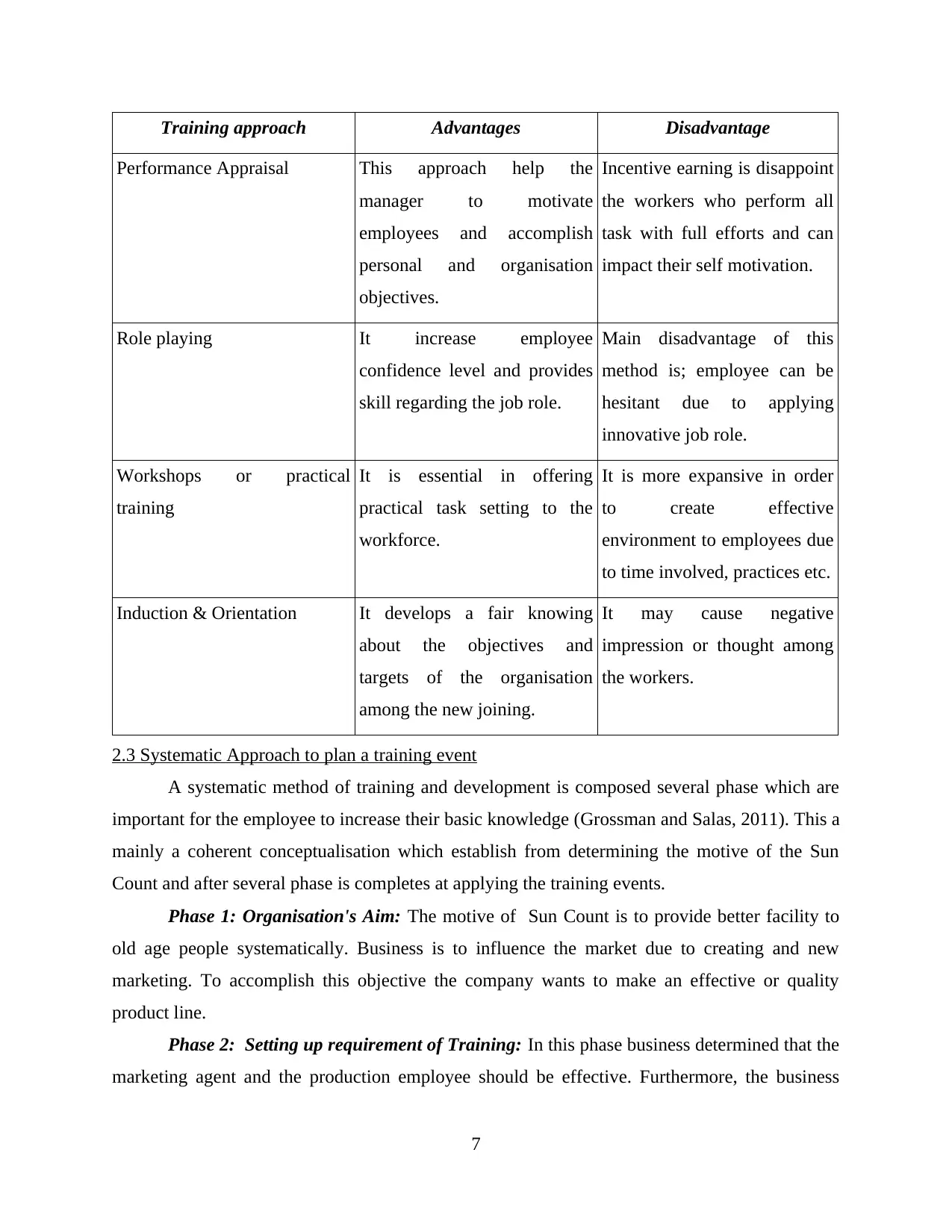
Training approach Advantages Disadvantage
Performance Appraisal This approach help the
manager to motivate
employees and accomplish
personal and organisation
objectives.
Incentive earning is disappoint
the workers who perform all
task with full efforts and can
impact their self motivation.
Role playing It increase employee
confidence level and provides
skill regarding the job role.
Main disadvantage of this
method is; employee can be
hesitant due to applying
innovative job role.
Workshops or practical
training
It is essential in offering
practical task setting to the
workforce.
It is more expansive in order
to create effective
environment to employees due
to time involved, practices etc.
Induction & Orientation It develops a fair knowing
about the objectives and
targets of the organisation
among the new joining.
It may cause negative
impression or thought among
the workers.
2.3 Systematic Approach to plan a training event
A systematic method of training and development is composed several phase which are
important for the employee to increase their basic knowledge (Grossman and Salas, 2011). This a
mainly a coherent conceptualisation which establish from determining the motive of the Sun
Count and after several phase is completes at applying the training events.
Phase 1: Organisation's Aim: The motive of Sun Count is to provide better facility to
old age people systematically. Business is to influence the market due to creating and new
marketing. To accomplish this objective the company wants to make an effective or quality
product line.
Phase 2: Setting up requirement of Training: In this phase business determined that the
marketing agent and the production employee should be effective. Furthermore, the business
7
Performance Appraisal This approach help the
manager to motivate
employees and accomplish
personal and organisation
objectives.
Incentive earning is disappoint
the workers who perform all
task with full efforts and can
impact their self motivation.
Role playing It increase employee
confidence level and provides
skill regarding the job role.
Main disadvantage of this
method is; employee can be
hesitant due to applying
innovative job role.
Workshops or practical
training
It is essential in offering
practical task setting to the
workforce.
It is more expansive in order
to create effective
environment to employees due
to time involved, practices etc.
Induction & Orientation It develops a fair knowing
about the objectives and
targets of the organisation
among the new joining.
It may cause negative
impression or thought among
the workers.
2.3 Systematic Approach to plan a training event
A systematic method of training and development is composed several phase which are
important for the employee to increase their basic knowledge (Grossman and Salas, 2011). This a
mainly a coherent conceptualisation which establish from determining the motive of the Sun
Count and after several phase is completes at applying the training events.
Phase 1: Organisation's Aim: The motive of Sun Count is to provide better facility to
old age people systematically. Business is to influence the market due to creating and new
marketing. To accomplish this objective the company wants to make an effective or quality
product line.
Phase 2: Setting up requirement of Training: In this phase business determined that the
marketing agent and the production employee should be effective. Furthermore, the business
7
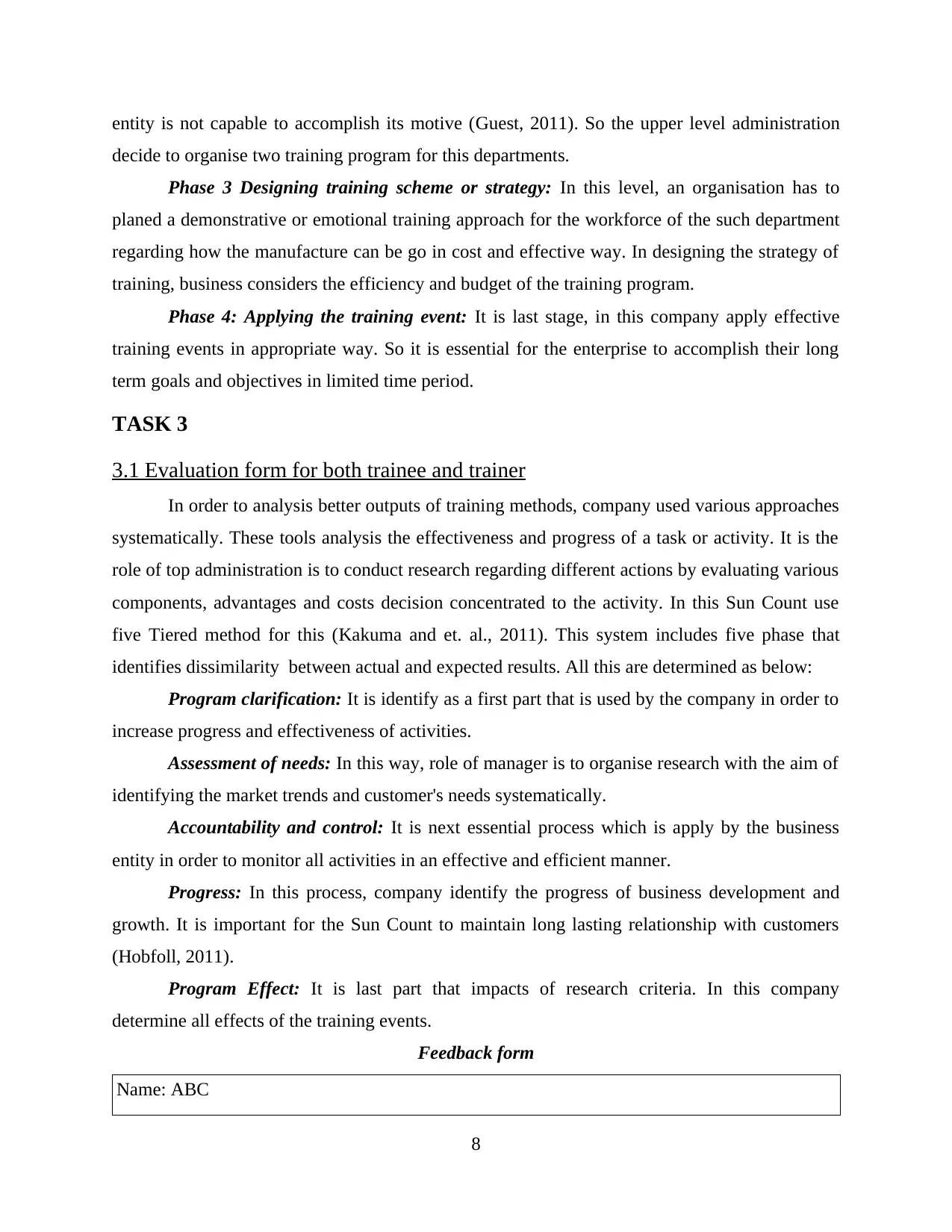
entity is not capable to accomplish its motive (Guest, 2011). So the upper level administration
decide to organise two training program for this departments.
Phase 3 Designing training scheme or strategy: In this level, an organisation has to
planed a demonstrative or emotional training approach for the workforce of the such department
regarding how the manufacture can be go in cost and effective way. In designing the strategy of
training, business considers the efficiency and budget of the training program.
Phase 4: Applying the training event: It is last stage, in this company apply effective
training events in appropriate way. So it is essential for the enterprise to accomplish their long
term goals and objectives in limited time period.
TASK 3
3.1 Evaluation form for both trainee and trainer
In order to analysis better outputs of training methods, company used various approaches
systematically. These tools analysis the effectiveness and progress of a task or activity. It is the
role of top administration is to conduct research regarding different actions by evaluating various
components, advantages and costs decision concentrated to the activity. In this Sun Count use
five Tiered method for this (Kakuma and et. al., 2011). This system includes five phase that
identifies dissimilarity between actual and expected results. All this are determined as below:
Program clarification: It is identify as a first part that is used by the company in order to
increase progress and effectiveness of activities.
Assessment of needs: In this way, role of manager is to organise research with the aim of
identifying the market trends and customer's needs systematically.
Accountability and control: It is next essential process which is apply by the business
entity in order to monitor all activities in an effective and efficient manner.
Progress: In this process, company identify the progress of business development and
growth. It is important for the Sun Count to maintain long lasting relationship with customers
(Hobfoll, 2011).
Program Effect: It is last part that impacts of research criteria. In this company
determine all effects of the training events.
Feedback form
Name: ABC
8
decide to organise two training program for this departments.
Phase 3 Designing training scheme or strategy: In this level, an organisation has to
planed a demonstrative or emotional training approach for the workforce of the such department
regarding how the manufacture can be go in cost and effective way. In designing the strategy of
training, business considers the efficiency and budget of the training program.
Phase 4: Applying the training event: It is last stage, in this company apply effective
training events in appropriate way. So it is essential for the enterprise to accomplish their long
term goals and objectives in limited time period.
TASK 3
3.1 Evaluation form for both trainee and trainer
In order to analysis better outputs of training methods, company used various approaches
systematically. These tools analysis the effectiveness and progress of a task or activity. It is the
role of top administration is to conduct research regarding different actions by evaluating various
components, advantages and costs decision concentrated to the activity. In this Sun Count use
five Tiered method for this (Kakuma and et. al., 2011). This system includes five phase that
identifies dissimilarity between actual and expected results. All this are determined as below:
Program clarification: It is identify as a first part that is used by the company in order to
increase progress and effectiveness of activities.
Assessment of needs: In this way, role of manager is to organise research with the aim of
identifying the market trends and customer's needs systematically.
Accountability and control: It is next essential process which is apply by the business
entity in order to monitor all activities in an effective and efficient manner.
Progress: In this process, company identify the progress of business development and
growth. It is important for the Sun Count to maintain long lasting relationship with customers
(Hobfoll, 2011).
Program Effect: It is last part that impacts of research criteria. In this company
determine all effects of the training events.
Feedback form
Name: ABC
8
Secure Best Marks with AI Grader
Need help grading? Try our AI Grader for instant feedback on your assignments.
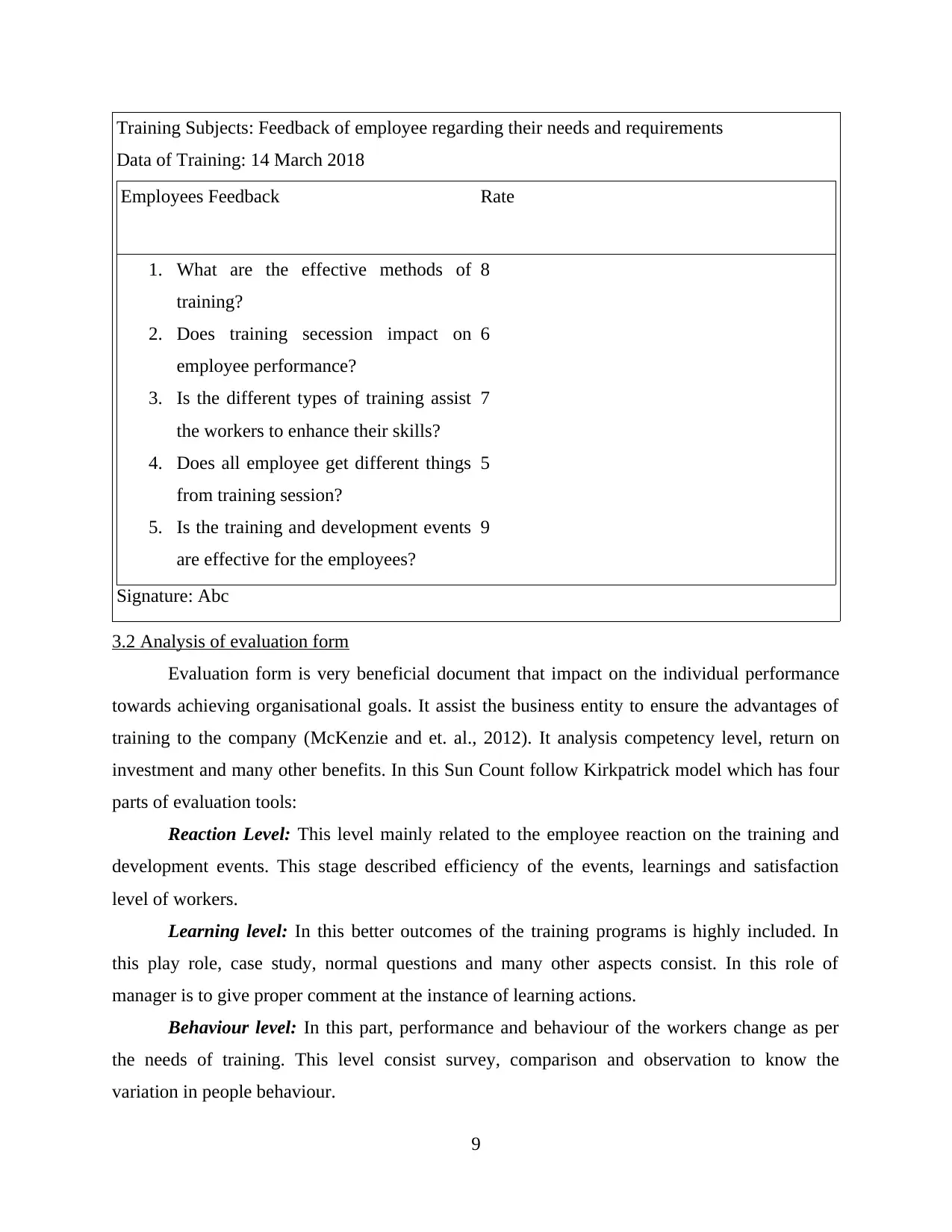
Training Subjects: Feedback of employee regarding their needs and requirements
Data of Training: 14 March 2018
Employees Feedback Rate
1. What are the effective methods of
training?
2. Does training secession impact on
employee performance?
3. Is the different types of training assist
the workers to enhance their skills?
4. Does all employee get different things
from training session?
5. Is the training and development events
are effective for the employees?
8
6
7
5
9
Signature: Abc
3.2 Analysis of evaluation form
Evaluation form is very beneficial document that impact on the individual performance
towards achieving organisational goals. It assist the business entity to ensure the advantages of
training to the company (McKenzie and et. al., 2012). It analysis competency level, return on
investment and many other benefits. In this Sun Count follow Kirkpatrick model which has four
parts of evaluation tools:
Reaction Level: This level mainly related to the employee reaction on the training and
development events. This stage described efficiency of the events, learnings and satisfaction
level of workers.
Learning level: In this better outcomes of the training programs is highly included. In
this play role, case study, normal questions and many other aspects consist. In this role of
manager is to give proper comment at the instance of learning actions.
Behaviour level: In this part, performance and behaviour of the workers change as per
the needs of training. This level consist survey, comparison and observation to know the
variation in people behaviour.
9
Data of Training: 14 March 2018
Employees Feedback Rate
1. What are the effective methods of
training?
2. Does training secession impact on
employee performance?
3. Is the different types of training assist
the workers to enhance their skills?
4. Does all employee get different things
from training session?
5. Is the training and development events
are effective for the employees?
8
6
7
5
9
Signature: Abc
3.2 Analysis of evaluation form
Evaluation form is very beneficial document that impact on the individual performance
towards achieving organisational goals. It assist the business entity to ensure the advantages of
training to the company (McKenzie and et. al., 2012). It analysis competency level, return on
investment and many other benefits. In this Sun Count follow Kirkpatrick model which has four
parts of evaluation tools:
Reaction Level: This level mainly related to the employee reaction on the training and
development events. This stage described efficiency of the events, learnings and satisfaction
level of workers.
Learning level: In this better outcomes of the training programs is highly included. In
this play role, case study, normal questions and many other aspects consist. In this role of
manager is to give proper comment at the instance of learning actions.
Behaviour level: In this part, performance and behaviour of the workers change as per
the needs of training. This level consist survey, comparison and observation to know the
variation in people behaviour.
9
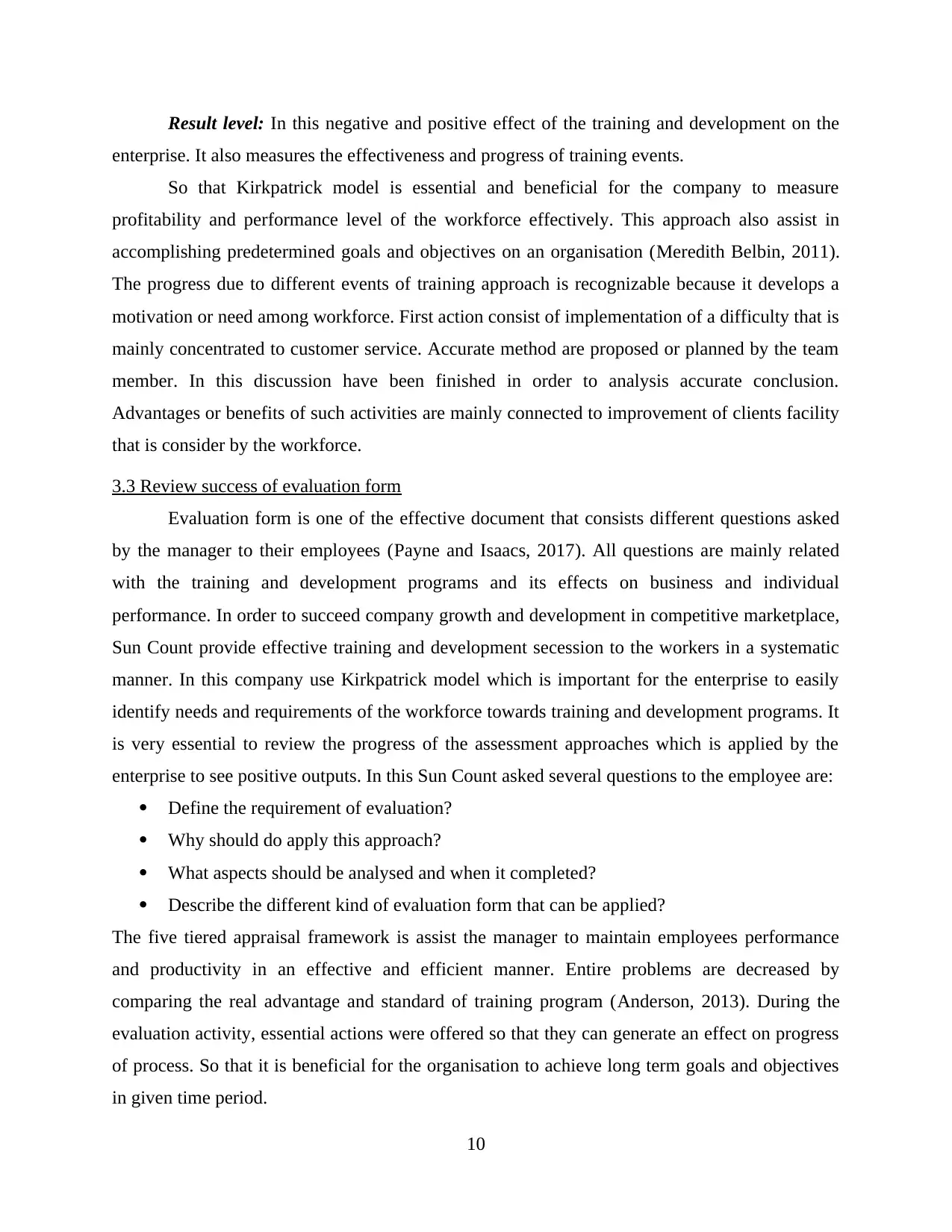
Result level: In this negative and positive effect of the training and development on the
enterprise. It also measures the effectiveness and progress of training events.
So that Kirkpatrick model is essential and beneficial for the company to measure
profitability and performance level of the workforce effectively. This approach also assist in
accomplishing predetermined goals and objectives on an organisation (Meredith Belbin, 2011).
The progress due to different events of training approach is recognizable because it develops a
motivation or need among workforce. First action consist of implementation of a difficulty that is
mainly concentrated to customer service. Accurate method are proposed or planned by the team
member. In this discussion have been finished in order to analysis accurate conclusion.
Advantages or benefits of such activities are mainly connected to improvement of clients facility
that is consider by the workforce.
3.3 Review success of evaluation form
Evaluation form is one of the effective document that consists different questions asked
by the manager to their employees (Payne and Isaacs, 2017). All questions are mainly related
with the training and development programs and its effects on business and individual
performance. In order to succeed company growth and development in competitive marketplace,
Sun Count provide effective training and development secession to the workers in a systematic
manner. In this company use Kirkpatrick model which is important for the enterprise to easily
identify needs and requirements of the workforce towards training and development programs. It
is very essential to review the progress of the assessment approaches which is applied by the
enterprise to see positive outputs. In this Sun Count asked several questions to the employee are:
Define the requirement of evaluation?
Why should do apply this approach?
What aspects should be analysed and when it completed?
Describe the different kind of evaluation form that can be applied?
The five tiered appraisal framework is assist the manager to maintain employees performance
and productivity in an effective and efficient manner. Entire problems are decreased by
comparing the real advantage and standard of training program (Anderson, 2013). During the
evaluation activity, essential actions were offered so that they can generate an effect on progress
of process. So that it is beneficial for the organisation to achieve long term goals and objectives
in given time period.
10
enterprise. It also measures the effectiveness and progress of training events.
So that Kirkpatrick model is essential and beneficial for the company to measure
profitability and performance level of the workforce effectively. This approach also assist in
accomplishing predetermined goals and objectives on an organisation (Meredith Belbin, 2011).
The progress due to different events of training approach is recognizable because it develops a
motivation or need among workforce. First action consist of implementation of a difficulty that is
mainly concentrated to customer service. Accurate method are proposed or planned by the team
member. In this discussion have been finished in order to analysis accurate conclusion.
Advantages or benefits of such activities are mainly connected to improvement of clients facility
that is consider by the workforce.
3.3 Review success of evaluation form
Evaluation form is one of the effective document that consists different questions asked
by the manager to their employees (Payne and Isaacs, 2017). All questions are mainly related
with the training and development programs and its effects on business and individual
performance. In order to succeed company growth and development in competitive marketplace,
Sun Count provide effective training and development secession to the workers in a systematic
manner. In this company use Kirkpatrick model which is important for the enterprise to easily
identify needs and requirements of the workforce towards training and development programs. It
is very essential to review the progress of the assessment approaches which is applied by the
enterprise to see positive outputs. In this Sun Count asked several questions to the employee are:
Define the requirement of evaluation?
Why should do apply this approach?
What aspects should be analysed and when it completed?
Describe the different kind of evaluation form that can be applied?
The five tiered appraisal framework is assist the manager to maintain employees performance
and productivity in an effective and efficient manner. Entire problems are decreased by
comparing the real advantage and standard of training program (Anderson, 2013). During the
evaluation activity, essential actions were offered so that they can generate an effect on progress
of process. So that it is beneficial for the organisation to achieve long term goals and objectives
in given time period.
10
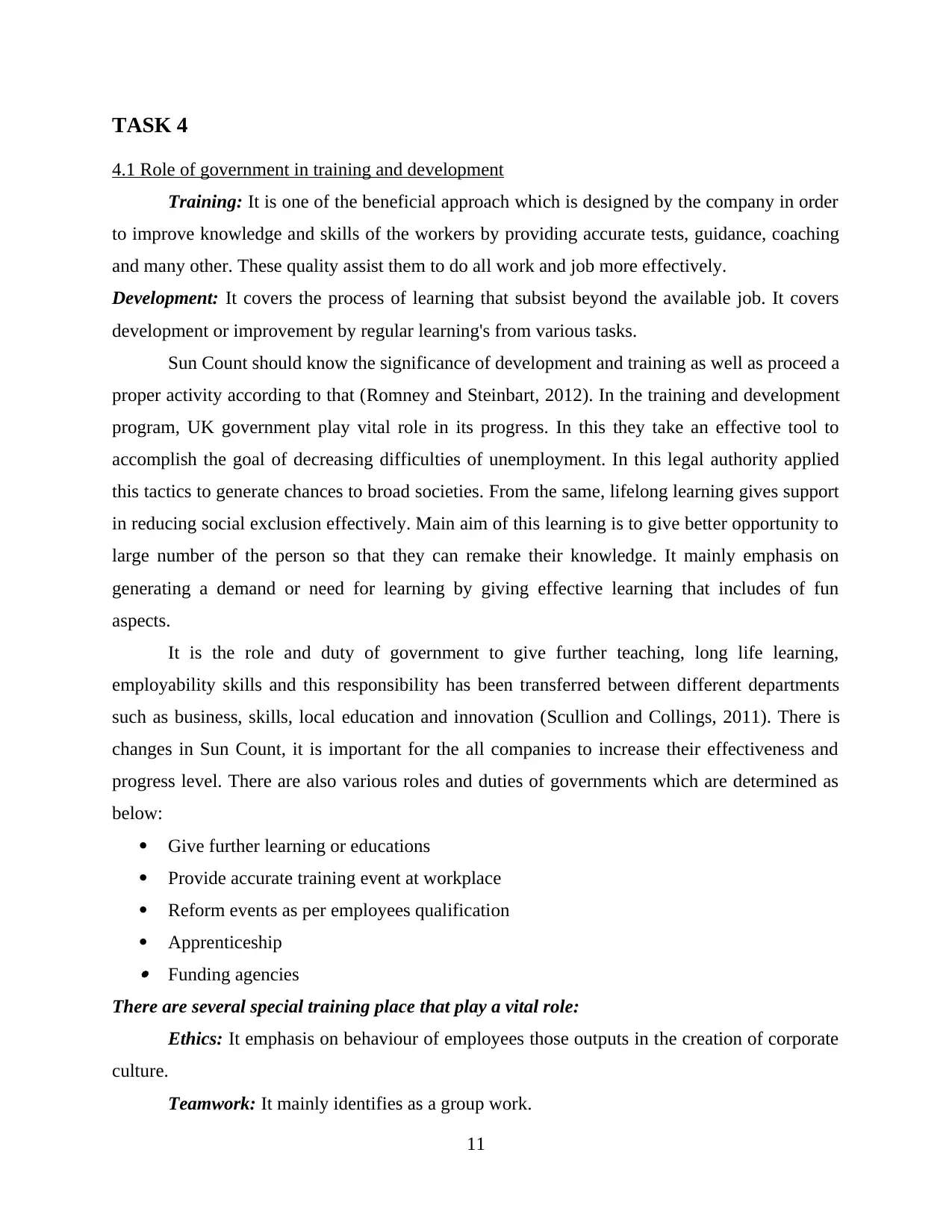
TASK 4
4.1 Role of government in training and development
Training: It is one of the beneficial approach which is designed by the company in order
to improve knowledge and skills of the workers by providing accurate tests, guidance, coaching
and many other. These quality assist them to do all work and job more effectively.
Development: It covers the process of learning that subsist beyond the available job. It covers
development or improvement by regular learning's from various tasks.
Sun Count should know the significance of development and training as well as proceed a
proper activity according to that (Romney and Steinbart, 2012). In the training and development
program, UK government play vital role in its progress. In this they take an effective tool to
accomplish the goal of decreasing difficulties of unemployment. In this legal authority applied
this tactics to generate chances to broad societies. From the same, lifelong learning gives support
in reducing social exclusion effectively. Main aim of this learning is to give better opportunity to
large number of the person so that they can remake their knowledge. It mainly emphasis on
generating a demand or need for learning by giving effective learning that includes of fun
aspects.
It is the role and duty of government to give further teaching, long life learning,
employability skills and this responsibility has been transferred between different departments
such as business, skills, local education and innovation (Scullion and Collings, 2011). There is
changes in Sun Count, it is important for the all companies to increase their effectiveness and
progress level. There are also various roles and duties of governments which are determined as
below:
Give further learning or educations
Provide accurate training event at workplace
Reform events as per employees qualification
Apprenticeship Funding agencies
There are several special training place that play a vital role:
Ethics: It emphasis on behaviour of employees those outputs in the creation of corporate
culture.
Teamwork: It mainly identifies as a group work.
11
4.1 Role of government in training and development
Training: It is one of the beneficial approach which is designed by the company in order
to improve knowledge and skills of the workers by providing accurate tests, guidance, coaching
and many other. These quality assist them to do all work and job more effectively.
Development: It covers the process of learning that subsist beyond the available job. It covers
development or improvement by regular learning's from various tasks.
Sun Count should know the significance of development and training as well as proceed a
proper activity according to that (Romney and Steinbart, 2012). In the training and development
program, UK government play vital role in its progress. In this they take an effective tool to
accomplish the goal of decreasing difficulties of unemployment. In this legal authority applied
this tactics to generate chances to broad societies. From the same, lifelong learning gives support
in reducing social exclusion effectively. Main aim of this learning is to give better opportunity to
large number of the person so that they can remake their knowledge. It mainly emphasis on
generating a demand or need for learning by giving effective learning that includes of fun
aspects.
It is the role and duty of government to give further teaching, long life learning,
employability skills and this responsibility has been transferred between different departments
such as business, skills, local education and innovation (Scullion and Collings, 2011). There is
changes in Sun Count, it is important for the all companies to increase their effectiveness and
progress level. There are also various roles and duties of governments which are determined as
below:
Give further learning or educations
Provide accurate training event at workplace
Reform events as per employees qualification
Apprenticeship Funding agencies
There are several special training place that play a vital role:
Ethics: It emphasis on behaviour of employees those outputs in the creation of corporate
culture.
Teamwork: It mainly identifies as a group work.
11
Paraphrase This Document
Need a fresh take? Get an instant paraphrase of this document with our AI Paraphraser
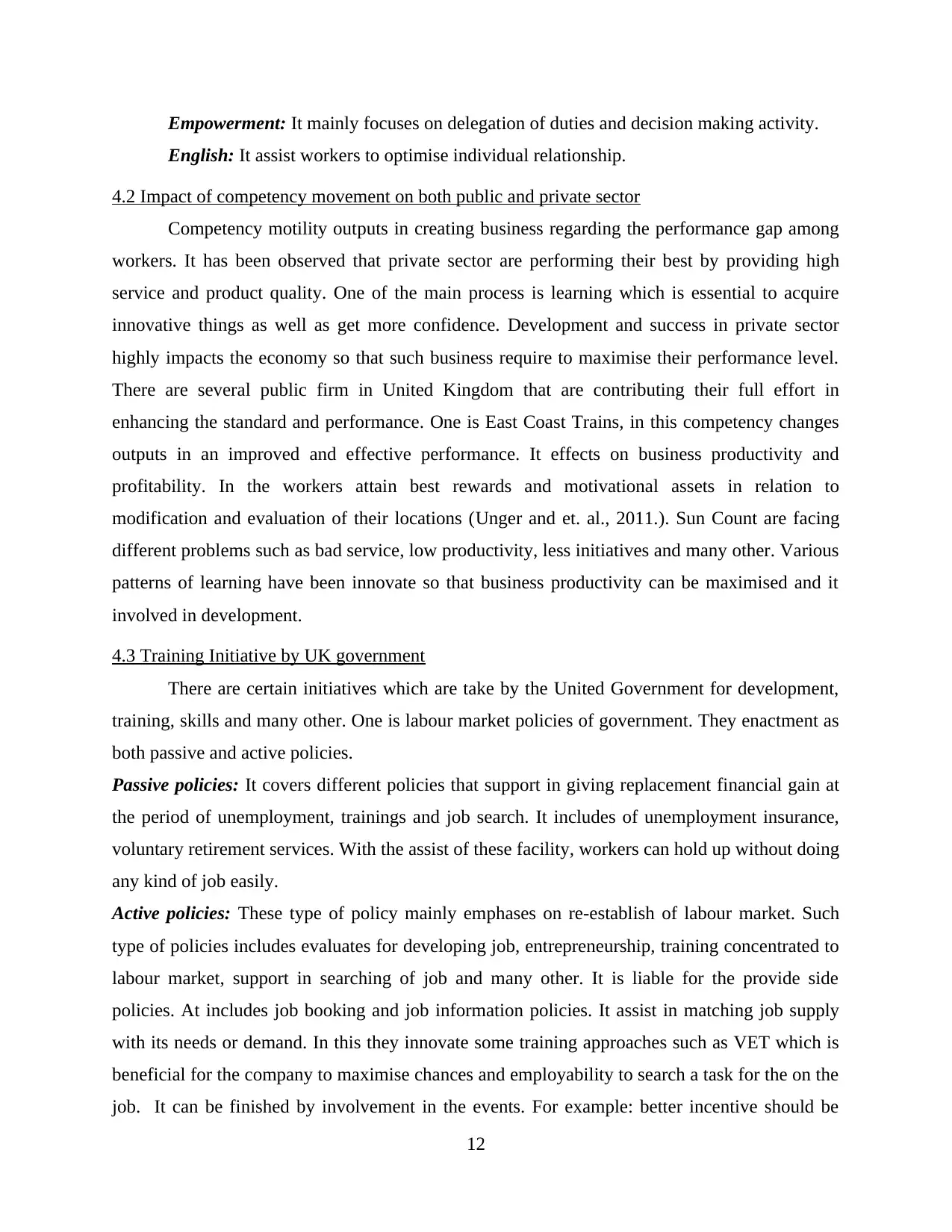
Empowerment: It mainly focuses on delegation of duties and decision making activity.
English: It assist workers to optimise individual relationship.
4.2 Impact of competency movement on both public and private sector
Competency motility outputs in creating business regarding the performance gap among
workers. It has been observed that private sector are performing their best by providing high
service and product quality. One of the main process is learning which is essential to acquire
innovative things as well as get more confidence. Development and success in private sector
highly impacts the economy so that such business require to maximise their performance level.
There are several public firm in United Kingdom that are contributing their full effort in
enhancing the standard and performance. One is East Coast Trains, in this competency changes
outputs in an improved and effective performance. It effects on business productivity and
profitability. In the workers attain best rewards and motivational assets in relation to
modification and evaluation of their locations (Unger and et. al., 2011.). Sun Count are facing
different problems such as bad service, low productivity, less initiatives and many other. Various
patterns of learning have been innovate so that business productivity can be maximised and it
involved in development.
4.3 Training Initiative by UK government
There are certain initiatives which are take by the United Government for development,
training, skills and many other. One is labour market policies of government. They enactment as
both passive and active policies.
Passive policies: It covers different policies that support in giving replacement financial gain at
the period of unemployment, trainings and job search. It includes of unemployment insurance,
voluntary retirement services. With the assist of these facility, workers can hold up without doing
any kind of job easily.
Active policies: These type of policy mainly emphases on re-establish of labour market. Such
type of policies includes evaluates for developing job, entrepreneurship, training concentrated to
labour market, support in searching of job and many other. It is liable for the provide side
policies. At includes job booking and job information policies. It assist in matching job supply
with its needs or demand. In this they innovate some training approaches such as VET which is
beneficial for the company to maximise chances and employability to search a task for the on the
job. It can be finished by involvement in the events. For example: better incentive should be
12
English: It assist workers to optimise individual relationship.
4.2 Impact of competency movement on both public and private sector
Competency motility outputs in creating business regarding the performance gap among
workers. It has been observed that private sector are performing their best by providing high
service and product quality. One of the main process is learning which is essential to acquire
innovative things as well as get more confidence. Development and success in private sector
highly impacts the economy so that such business require to maximise their performance level.
There are several public firm in United Kingdom that are contributing their full effort in
enhancing the standard and performance. One is East Coast Trains, in this competency changes
outputs in an improved and effective performance. It effects on business productivity and
profitability. In the workers attain best rewards and motivational assets in relation to
modification and evaluation of their locations (Unger and et. al., 2011.). Sun Count are facing
different problems such as bad service, low productivity, less initiatives and many other. Various
patterns of learning have been innovate so that business productivity can be maximised and it
involved in development.
4.3 Training Initiative by UK government
There are certain initiatives which are take by the United Government for development,
training, skills and many other. One is labour market policies of government. They enactment as
both passive and active policies.
Passive policies: It covers different policies that support in giving replacement financial gain at
the period of unemployment, trainings and job search. It includes of unemployment insurance,
voluntary retirement services. With the assist of these facility, workers can hold up without doing
any kind of job easily.
Active policies: These type of policy mainly emphases on re-establish of labour market. Such
type of policies includes evaluates for developing job, entrepreneurship, training concentrated to
labour market, support in searching of job and many other. It is liable for the provide side
policies. At includes job booking and job information policies. It assist in matching job supply
with its needs or demand. In this they innovate some training approaches such as VET which is
beneficial for the company to maximise chances and employability to search a task for the on the
job. It can be finished by involvement in the events. For example: better incentive should be
12
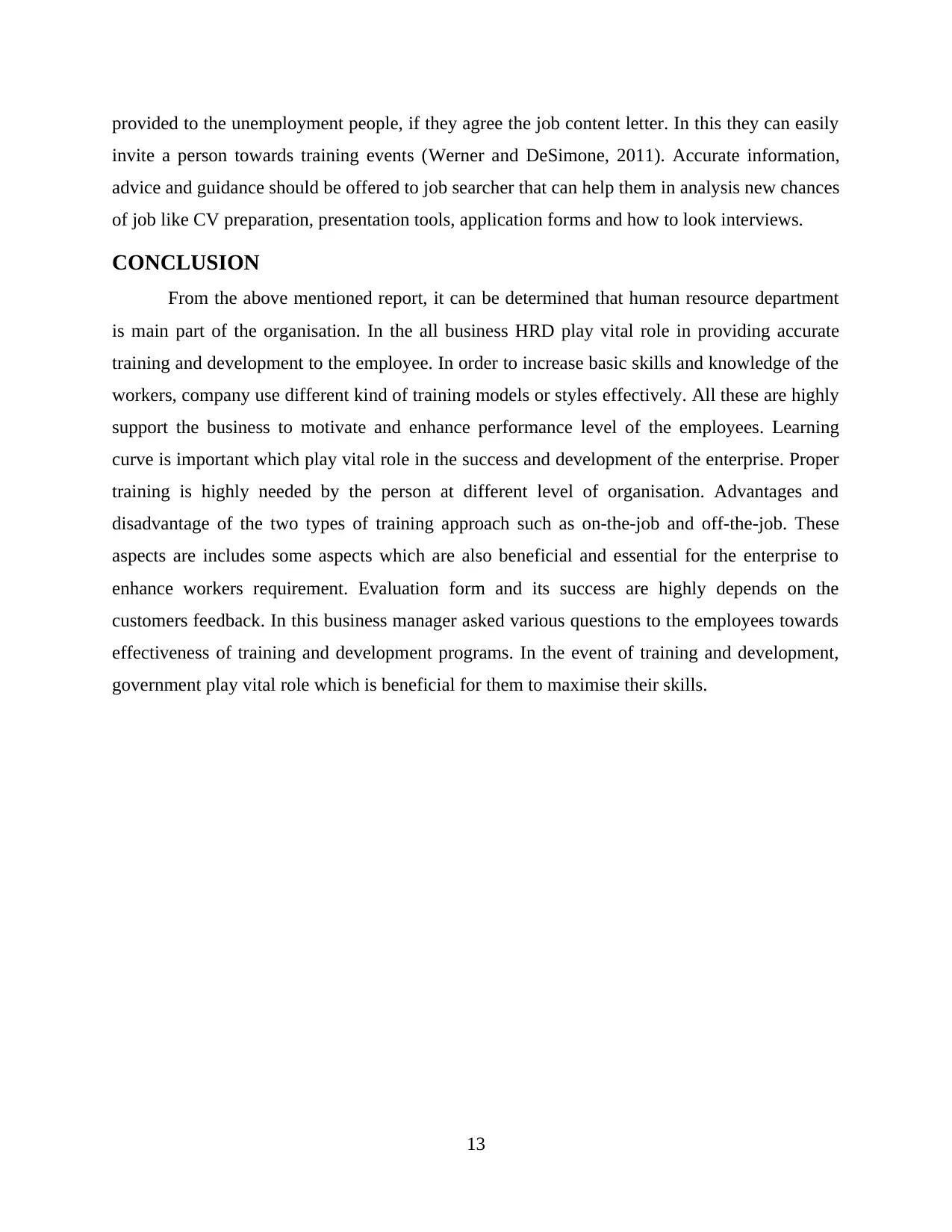
provided to the unemployment people, if they agree the job content letter. In this they can easily
invite a person towards training events (Werner and DeSimone, 2011). Accurate information,
advice and guidance should be offered to job searcher that can help them in analysis new chances
of job like CV preparation, presentation tools, application forms and how to look interviews.
CONCLUSION
From the above mentioned report, it can be determined that human resource department
is main part of the organisation. In the all business HRD play vital role in providing accurate
training and development to the employee. In order to increase basic skills and knowledge of the
workers, company use different kind of training models or styles effectively. All these are highly
support the business to motivate and enhance performance level of the employees. Learning
curve is important which play vital role in the success and development of the enterprise. Proper
training is highly needed by the person at different level of organisation. Advantages and
disadvantage of the two types of training approach such as on-the-job and off-the-job. These
aspects are includes some aspects which are also beneficial and essential for the enterprise to
enhance workers requirement. Evaluation form and its success are highly depends on the
customers feedback. In this business manager asked various questions to the employees towards
effectiveness of training and development programs. In the event of training and development,
government play vital role which is beneficial for them to maximise their skills.
13
invite a person towards training events (Werner and DeSimone, 2011). Accurate information,
advice and guidance should be offered to job searcher that can help them in analysis new chances
of job like CV preparation, presentation tools, application forms and how to look interviews.
CONCLUSION
From the above mentioned report, it can be determined that human resource department
is main part of the organisation. In the all business HRD play vital role in providing accurate
training and development to the employee. In order to increase basic skills and knowledge of the
workers, company use different kind of training models or styles effectively. All these are highly
support the business to motivate and enhance performance level of the employees. Learning
curve is important which play vital role in the success and development of the enterprise. Proper
training is highly needed by the person at different level of organisation. Advantages and
disadvantage of the two types of training approach such as on-the-job and off-the-job. These
aspects are includes some aspects which are also beneficial and essential for the enterprise to
enhance workers requirement. Evaluation form and its success are highly depends on the
customers feedback. In this business manager asked various questions to the employees towards
effectiveness of training and development programs. In the event of training and development,
government play vital role which is beneficial for them to maximise their skills.
13
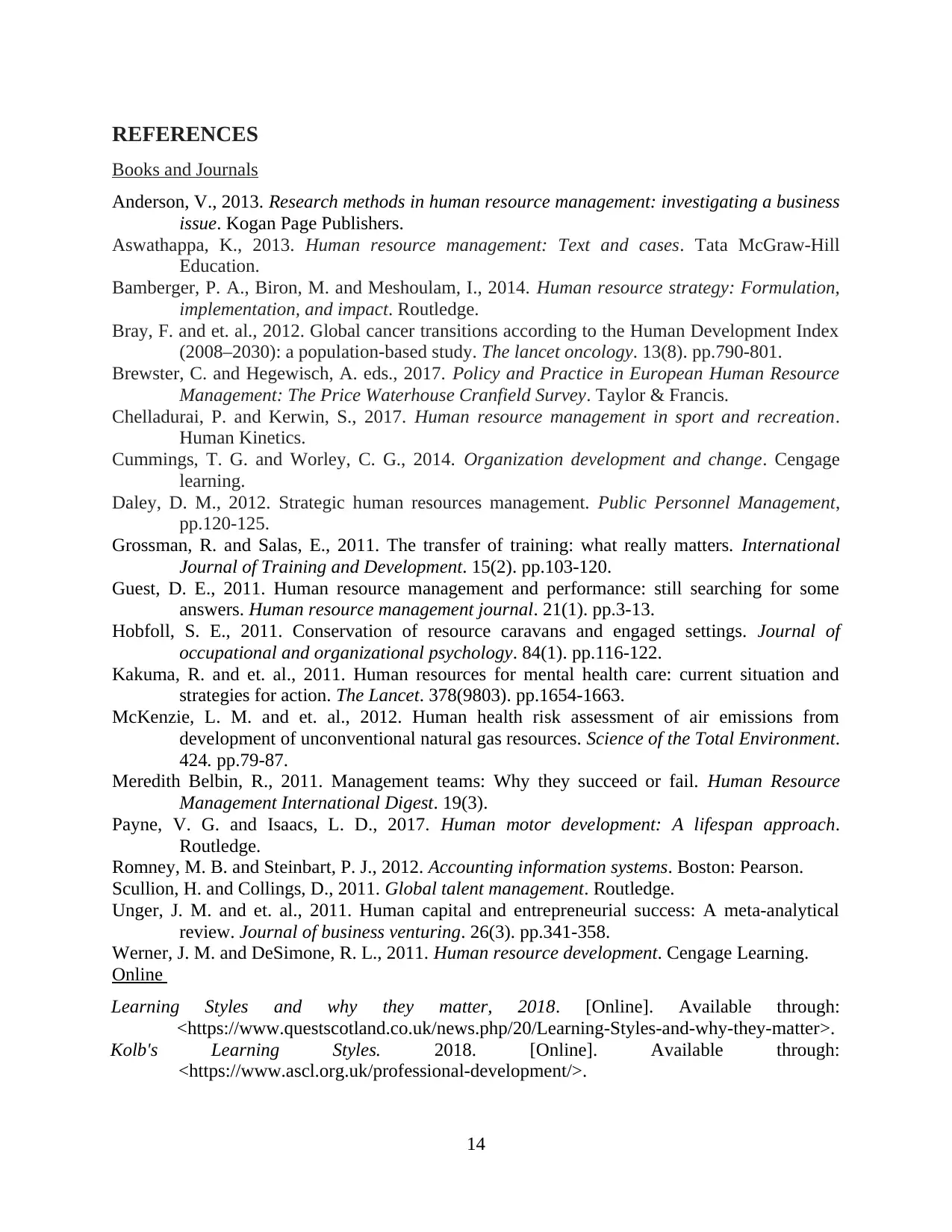
REFERENCES
Books and Journals
Anderson, V., 2013. Research methods in human resource management: investigating a business
issue. Kogan Page Publishers.
Aswathappa, K., 2013. Human resource management: Text and cases. Tata McGraw-Hill
Education.
Bamberger, P. A., Biron, M. and Meshoulam, I., 2014. Human resource strategy: Formulation,
implementation, and impact. Routledge.
Bray, F. and et. al., 2012. Global cancer transitions according to the Human Development Index
(2008–2030): a population-based study. The lancet oncology. 13(8). pp.790-801.
Brewster, C. and Hegewisch, A. eds., 2017. Policy and Practice in European Human Resource
Management: The Price Waterhouse Cranfield Survey. Taylor & Francis.
Chelladurai, P. and Kerwin, S., 2017. Human resource management in sport and recreation.
Human Kinetics.
Cummings, T. G. and Worley, C. G., 2014. Organization development and change. Cengage
learning.
Daley, D. M., 2012. Strategic human resources management. Public Personnel Management,
pp.120-125.
Grossman, R. and Salas, E., 2011. The transfer of training: what really matters. International
Journal of Training and Development. 15(2). pp.103-120.
Guest, D. E., 2011. Human resource management and performance: still searching for some
answers. Human resource management journal. 21(1). pp.3-13.
Hobfoll, S. E., 2011. Conservation of resource caravans and engaged settings. Journal of
occupational and organizational psychology. 84(1). pp.116-122.
Kakuma, R. and et. al., 2011. Human resources for mental health care: current situation and
strategies for action. The Lancet. 378(9803). pp.1654-1663.
McKenzie, L. M. and et. al., 2012. Human health risk assessment of air emissions from
development of unconventional natural gas resources. Science of the Total Environment.
424. pp.79-87.
Meredith Belbin, R., 2011. Management teams: Why they succeed or fail. Human Resource
Management International Digest. 19(3).
Payne, V. G. and Isaacs, L. D., 2017. Human motor development: A lifespan approach.
Routledge.
Romney, M. B. and Steinbart, P. J., 2012. Accounting information systems. Boston: Pearson.
Scullion, H. and Collings, D., 2011. Global talent management. Routledge.
Unger, J. M. and et. al., 2011. Human capital and entrepreneurial success: A meta-analytical
review. Journal of business venturing. 26(3). pp.341-358.
Werner, J. M. and DeSimone, R. L., 2011. Human resource development. Cengage Learning.
Online
Learning Styles and why they matter, 2018. [Online]. Available through:
<https://www.questscotland.co.uk/news.php/20/Learning-Styles-and-why-they-matter>.
Kolb's Learning Styles. 2018. [Online]. Available through:
<https://www.ascl.org.uk/professional-development/>.
14
Books and Journals
Anderson, V., 2013. Research methods in human resource management: investigating a business
issue. Kogan Page Publishers.
Aswathappa, K., 2013. Human resource management: Text and cases. Tata McGraw-Hill
Education.
Bamberger, P. A., Biron, M. and Meshoulam, I., 2014. Human resource strategy: Formulation,
implementation, and impact. Routledge.
Bray, F. and et. al., 2012. Global cancer transitions according to the Human Development Index
(2008–2030): a population-based study. The lancet oncology. 13(8). pp.790-801.
Brewster, C. and Hegewisch, A. eds., 2017. Policy and Practice in European Human Resource
Management: The Price Waterhouse Cranfield Survey. Taylor & Francis.
Chelladurai, P. and Kerwin, S., 2017. Human resource management in sport and recreation.
Human Kinetics.
Cummings, T. G. and Worley, C. G., 2014. Organization development and change. Cengage
learning.
Daley, D. M., 2012. Strategic human resources management. Public Personnel Management,
pp.120-125.
Grossman, R. and Salas, E., 2011. The transfer of training: what really matters. International
Journal of Training and Development. 15(2). pp.103-120.
Guest, D. E., 2011. Human resource management and performance: still searching for some
answers. Human resource management journal. 21(1). pp.3-13.
Hobfoll, S. E., 2011. Conservation of resource caravans and engaged settings. Journal of
occupational and organizational psychology. 84(1). pp.116-122.
Kakuma, R. and et. al., 2011. Human resources for mental health care: current situation and
strategies for action. The Lancet. 378(9803). pp.1654-1663.
McKenzie, L. M. and et. al., 2012. Human health risk assessment of air emissions from
development of unconventional natural gas resources. Science of the Total Environment.
424. pp.79-87.
Meredith Belbin, R., 2011. Management teams: Why they succeed or fail. Human Resource
Management International Digest. 19(3).
Payne, V. G. and Isaacs, L. D., 2017. Human motor development: A lifespan approach.
Routledge.
Romney, M. B. and Steinbart, P. J., 2012. Accounting information systems. Boston: Pearson.
Scullion, H. and Collings, D., 2011. Global talent management. Routledge.
Unger, J. M. and et. al., 2011. Human capital and entrepreneurial success: A meta-analytical
review. Journal of business venturing. 26(3). pp.341-358.
Werner, J. M. and DeSimone, R. L., 2011. Human resource development. Cengage Learning.
Online
Learning Styles and why they matter, 2018. [Online]. Available through:
<https://www.questscotland.co.uk/news.php/20/Learning-Styles-and-why-they-matter>.
Kolb's Learning Styles. 2018. [Online]. Available through:
<https://www.ascl.org.uk/professional-development/>.
14
1 out of 16
Related Documents
Your All-in-One AI-Powered Toolkit for Academic Success.
+13062052269
info@desklib.com
Available 24*7 on WhatsApp / Email
![[object Object]](/_next/static/media/star-bottom.7253800d.svg)
Unlock your academic potential
© 2024 | Zucol Services PVT LTD | All rights reserved.





